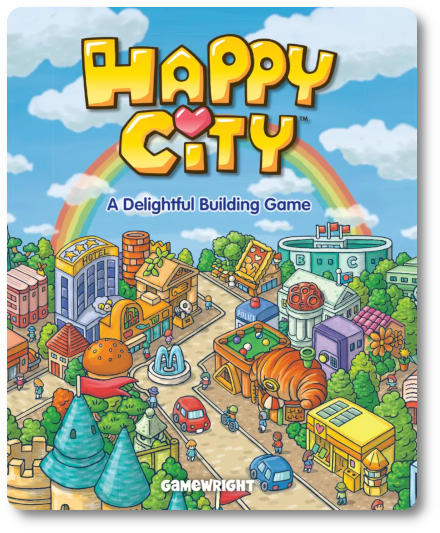
The Basics:
- For ages 6 and up (publisher suggests 10+)
- For 2 to 5 players
- Approximately 30 minutes to complete
Geek Skills
- Counting & Math
- Logical & Critical Decision Making
- Reading
- Pattern/Color Matching
- Strategy & Tactics
- Hand/Resource Management
Learning Curve
- Child – Easy
- Adult – Easy
Theme & Narrative:
- Prove you are the best mayor by helping plan the happiest city!
Endorsements:
- Gamer Geek approved!
- Parent Geek approved!
- Child Geek approved!
English designer and the founder of London-based design practice Heatherwick Studio, Thomas Heatherwick, said, “One great building does not make a great city.” In this game, players not only have one but many beautiful buildings to plan for and build. The goal is simple: make everyone happy! Take the time to build a city that balances population with joy, and you are sure to be the most popular mayor in history. But be careful. There is only so much space for both buildings and the people who will occupy your city.
Happy City, designed by Toshiki Sato, Airu Sato and published by Gamewright, is comprised of 30 Coin tokens (in the values of one and five), one First Player card, five Happy Market cards, 12 Residence cards, 66 Building cards, and 56 Bonus Building cards. The cards are a bit more durable than your standard playing card, and the tokens are made of thick cardboard. Artist たかみまこと (Makoto Takami) has done an outstanding job by providing the game with cute illustrations of the buildings that look like what they house (a library, for example, looks like a stack of books).
Plotting the Land
Complete the following steps to set up the basic game.
First, take the Building cards and divide them into three different stacks based on the card’s back. Next, shuffle each of these stacks separately and place face-down in the middle of the playing area to create a row of three draw decks. This row is referred to as the “building supply.”
Second, take the Residence cards and separate them by type, arranging them into three identical piles well within reach of all the players. When organizing each of these piles, make sure the number of cards contained is one less than the total number of players.
Third, find the “Expert” Bonus Building cards and place them back in the box (referred to the “Game Variants” section of this review to learn more about these cards), leaving only the Bonus Building cards. Finally, shuffle and randomly deal a number in a row equal to two more than the total number of players. For example, if playing with four players, you would deal six Bonus Building cards.
Fourth, place the Coin tokens into a pile and off to one side. This supply of tokens is referred to as the “Bank.” Feel free to assign one person to manage it if you like. Finally, give each player two “one value” Coin tokens and one Happy Market card. The player’s Happy Market card should be placed in front of them to start their “City” and on the side with a white background. Return any unused Happy Market cards to the game box.
That’s it for game setup. Determine who will go first and pass them the First Player card.
Building a Bright and Happy Future
Happy City is played in rounds and turns with no set number of turns per game. A game round and player’s turn are summarized here.
Step One: Income Phase
At the start of every round, all players collect “taxes” (the game refers to it as “income,” but let’s be honest here…) from the Bank. The total number of Coins they collect is based on the number of Coin icons currently visible in the player’s City. By default, each player will receive one Coin, provided by their starting Happy Market card.
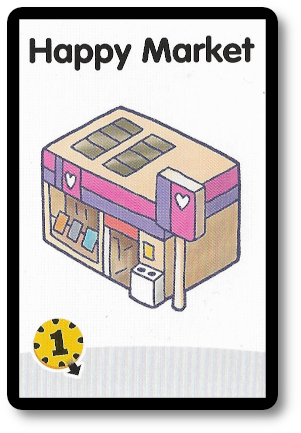
Step Two: Take Actions
Starting with the player who has the First Player card and continuing in turn order sequence, each player will take a set number of actions of their choice in sequential order.
Action One: Discard
The player’s first available action is also optional. The player may discard one face-up card currently in the building supply. If they decide to do so, they take the selected card and place it face-down in a discard pile at the end of the card’s row.
Action Two: Reveal Cards
The player’s second action, which is decidedly not optional, is drawing and revealing Building cards. The total number of Building cards that can only ever be revealed and in the building supply area is three, but these three can come from any of the three draw decks. On the back of each building card is the cost range of whatever the building might be. Players should look at these to help them identify what buildings might be revealed that they can afford. The cards drawn are placed face-up in the building supply area.
<backs of buildings>
If any of the Building draw decks are depleted, take its corresponding discard pile, shuffle, and place face-down to create a new draw deck.
Action Three: Purchase Building, Purchase Residence, or Visit the Bank
The player now has three actions available to them, but only one can be taken on their turn.
The player may purchase a Building card currently visible in the building supply area, but only if they have the Coins to pay for it and the building they want to buy isn’t already in their City. If the player can meet these requirements, they pay the bank and take the Building card, adding it to their City.
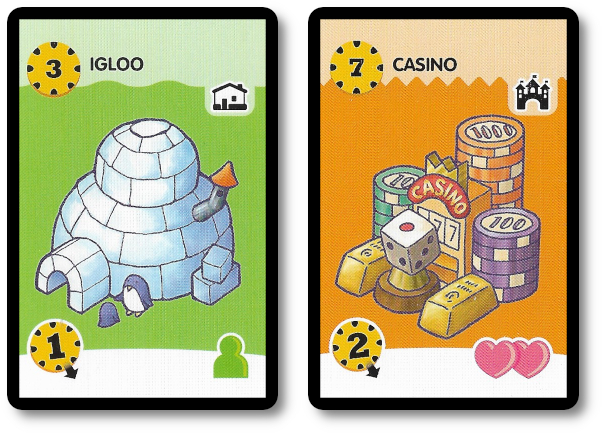
The player may purchase a Residence card currently visible, but only if they have the Coins to pay for it and the resident they want to buy isn’t already in their City. If the player can meet these requirements, they pay the bank and take the Residence card, adding it to their City.
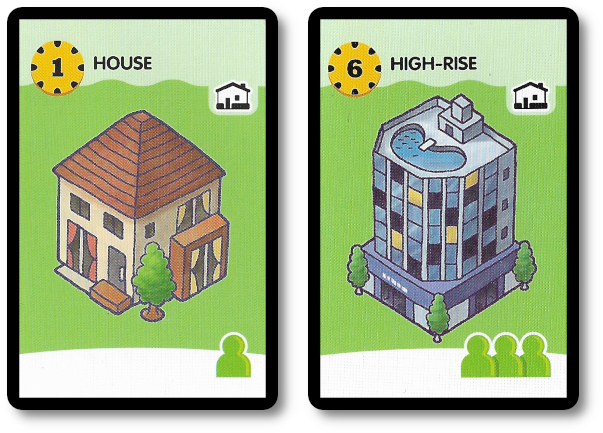
The player may decide they don’t want to purchase anything in the building supply (or cannot, regardless of how they feel about it). They collect one Coin from the bank and add it to their supply.
Action Four: Purchase Bonus Building
The final action is again optional and can only be taken once per game. As the player grows their City, they will start to have a collection of different Residence and Building cards. The Bonus Building cards are available for the player to purchase (as they would typically purchase a Building card from the building supply), but only if they meet the housing requirements of the Bonus Building card. If the player can meet these requirements, they can take and add the Bonus Building card to their City.
- Players can only have one Bonus Building card in their City during the game.
- A player is never required to purchase a Bonus Building even if they meet its requirements.
- A player’s City may only have a maximum of 10 cards, meaning that if the player wants to buy a Bonus Building during their turn that would maximize their City, they should take the option to collect one Coin from the bank and then purchase the Bonus Building.
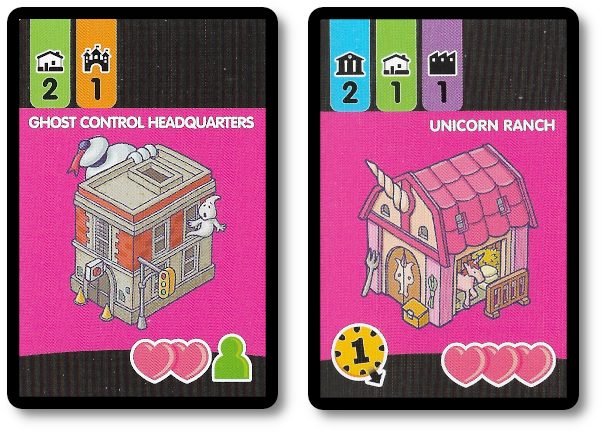
This completes the player’s turn. The next player now takes their turn, starting with step two. When the last player completes their turn, a new round begins. The First Player card remains with the player who received it at the game set up for the game’s duration.
Political Power Through Smiles
The game continues as summarized above until a player has ten cards in their City at the end of their turn. The round is then completed, ensuring everyone has the same number of turns per game.
Players now calculate how happy their City is. This is done by first counting all the visible hearts on their Building cards. They then take that number and multiply it by the number of Residences. For example, if the player had a total of five hearts and three residences, their score would be 15 (5 x 3). Note that some cards reduce the total happiness and residence of the City, as well. Take these into account when determining your score.
The player with the highest score has the happiest city, winning the game! If there is a tie, the player with the most Coins wins.
Game Variants
If playing with younger Child Geeks, you can simplify scoring by adding the total number of residences with the hearts instead of multiplying them.
Include the Expert Bonus Buildings to add a level of complexity and depth to the game. Use the Expert Bonus Buildings instead of the standard Bonus Buildings during game set up.
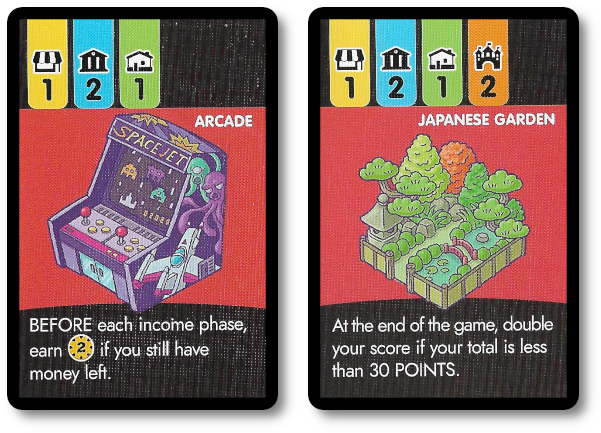
Instead of handing out the Happy Market cards to each player, place them in a row with their colored side face-up. Starting with the last player in the turn order sequence and going backward, each player selects a Happy Market card. When playing “expert mode,” the Happy Market cards have a color and an icon. These Happy Market cards now count as one of that specific building type and color. One step closer to meeting the Expert Bonus Building requirements!
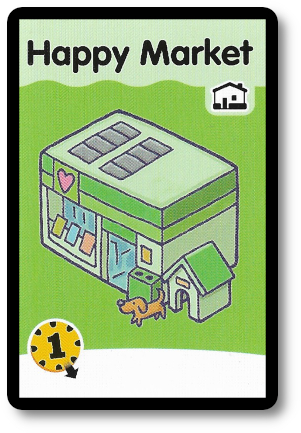
To learn more about Happy City, visit the game’s web page.
Final Word
 The Child Geeks had various levels of success regarding how fast they understood the rules, but nothing we observed suggested that the game was too complex or too simple for our youngest players. They enjoyed the game, but not as much as they enjoyed the artwork. According to one Child Geek, “I like the game because all the buildings are what they are selling. A shoe store is a shoe store, the library is a book, and I love the unicorn ranch!” Another Child Geek said, “I liked the game. It was fun to play, but I didn’t understand how I lost the first time. When I play it again, I’ll be sure to pay attention to how many people and how many hearts I have.” When the final brick was placed in the city, all the Child Geeks agreed that the game was an excellent time for all.
The Child Geeks had various levels of success regarding how fast they understood the rules, but nothing we observed suggested that the game was too complex or too simple for our youngest players. They enjoyed the game, but not as much as they enjoyed the artwork. According to one Child Geek, “I like the game because all the buildings are what they are selling. A shoe store is a shoe store, the library is a book, and I love the unicorn ranch!” Another Child Geek said, “I liked the game. It was fun to play, but I didn’t understand how I lost the first time. When I play it again, I’ll be sure to pay attention to how many people and how many hearts I have.” When the final brick was placed in the city, all the Child Geeks agreed that the game was an excellent time for all.
 The Parent Geeks very much enjoyed this fun little game. It was easy to learn, easy to teach, and a good deal of fun to play. According to one Parent Geek, “I like how it is very much a game that you can grasp, and it requires math and calculated thinking without being too difficult for anyone to understand. I’d play this with my family and other gamers anytime.” Another Parent Geek said, “Light and easy, fun to teach and even more, fun to play. The buildings are cute, and the game makes it easy to dive in.” Best of all, the Parent Geeks found that the basic game was engaging and challenging enough to keep them interested and the addition of the Expert Bonus Buildings was perfect for when just the adults wanted to play. The result was a game fully approved by the Parent Geeks, who were eager to build their happy city.
The Parent Geeks very much enjoyed this fun little game. It was easy to learn, easy to teach, and a good deal of fun to play. According to one Parent Geek, “I like how it is very much a game that you can grasp, and it requires math and calculated thinking without being too difficult for anyone to understand. I’d play this with my family and other gamers anytime.” Another Parent Geek said, “Light and easy, fun to teach and even more, fun to play. The buildings are cute, and the game makes it easy to dive in.” Best of all, the Parent Geeks found that the basic game was engaging and challenging enough to keep them interested and the addition of the Expert Bonus Buildings was perfect for when just the adults wanted to play. The result was a game fully approved by the Parent Geeks, who were eager to build their happy city.
 The Gamer Geeks felt Happy City was light and casual. It struck a perfect balance of complexity and depth without being too easy or too hard. It engaged them and kept them thinking from their very first to their very last turn. According to one Gamer Geek, “I think this is a nice little game. The rules are tight, there is room to be creative, but each choice you make will impact your end goal of winning. The game has just the right amount of strategy and tactics to make this a real winner if you are looking for a filler or a quick game with friends.” Another Gamer Geek said, “Good but not great. There are other games out there that are much more complex, but that isn’t a mark against this game. I think it is a wonderful introduction for anyone interested in tableau games. It did a great job of teaching you the basics and challenging you right from the start.” When all the Gamer Geeks put the last touches on their cities, they stepped back, and all agreed that the Happy City made them – well – happy.
The Gamer Geeks felt Happy City was light and casual. It struck a perfect balance of complexity and depth without being too easy or too hard. It engaged them and kept them thinking from their very first to their very last turn. According to one Gamer Geek, “I think this is a nice little game. The rules are tight, there is room to be creative, but each choice you make will impact your end goal of winning. The game has just the right amount of strategy and tactics to make this a real winner if you are looking for a filler or a quick game with friends.” Another Gamer Geek said, “Good but not great. There are other games out there that are much more complex, but that isn’t a mark against this game. I think it is a wonderful introduction for anyone interested in tableau games. It did a great job of teaching you the basics and challenging you right from the start.” When all the Gamer Geeks put the last touches on their cities, they stepped back, and all agreed that the Happy City made them – well – happy.
 I have always enjoyed how Gamewright approaches its game design. First, they take games with fascinating narratives and themes, ensuring that they will interest the gamer as they come to the table. They then go that extra step and tighten the rules to make the game accessible and engaging regardless of the player’s game playing level. This makes games from Gamewright entertaining to very casual players to expert elitists (to various degrees, of course). Happy City is no exception.
I have always enjoyed how Gamewright approaches its game design. First, they take games with fascinating narratives and themes, ensuring that they will interest the gamer as they come to the table. They then go that extra step and tighten the rules to make the game accessible and engaging regardless of the player’s game playing level. This makes games from Gamewright entertaining to very casual players to expert elitists (to various degrees, of course). Happy City is no exception.
I heard several players suggest that Happy City is a refined and limited version of Machi Koro, a pretty apt description. Happy City is most certainly a family game and targets casual players, wherein Machi Koro is much more focused on deeper player interaction and developing their city. This is interesting only as the two games approach the same goal on two very different roads. I only mentioned it here since it was mentioned so many times by others while we played.
As noted, this game is designated by the publisher for individuals who are 10-years-old and older. However, we had great success with a six-year-old Child Geek who teamed up with a parent in one game and then ran her city in the next. The game itself is not difficult to grasp. Turns are simple, and other players can help remind younger players what needs to be done next without making any choices for them. Since everything is out in the open, Child Geeks (and any geek for that matter) always have all the information they need to make a choice. This made the game very approachable and playable right from the start.
To be clear, just because a Child Geek can play the game doesn’t mean this is a “kids game.” Far from it. The basic game still requires players to think ahead, do math in their heads, continually look for growth opportunities, and make decisions that can lead to multiple paths. None of that is easy, but nor is it overwhelming, thanks to how a player’s turn is structured. Of course, adding the Expert Bonus Buildings into the game increases the complexity level. In addition, players must now consider the location of their cards and the order in which they purchase them. This added a great deal of depth to the game without adding more weight to the game. Regardless of how the game was played, the result was always easy to enjoy, casual, and a great experience.
This game was given to Father Geek as a review copy. Father Geek was not paid, bribed, wined, dined, or threatened in vain hopes of influencing this review. Such is the statuesque and legendary integrity of Father Geek.



